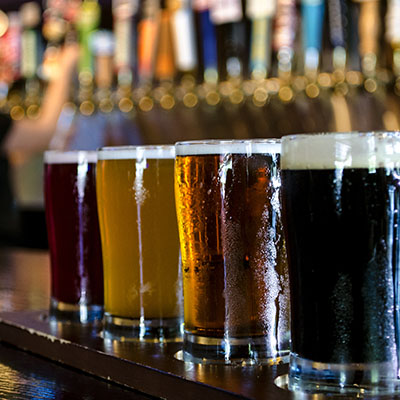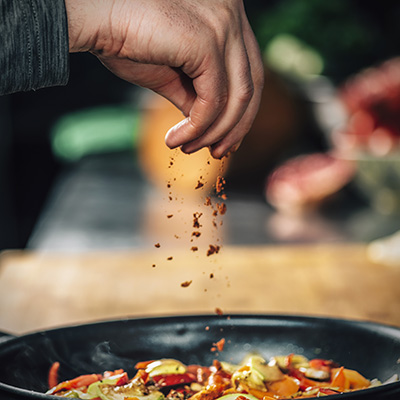Published: September 17, 2022

It’s the end of a long day, or maybe the start to a fun weekend … you lean back in your chair, hammock, front porch step, wherever, and crack open your favorite brew. Life. Is. Good.
But have you ever thought why your favorite beer IS your favorite? Nowadays, chances are (especially if you are a millennial) you’re drinking the product of one of nearly 10,000 craft breweries here in the U.S. and NOT one of the large traditional beer companies that have been such a significant part of the history of brewing in America (Budweiser Clydesdales, anyone?). And why are the beers that are popular today are so different from those our parents and grandparents enjoyed in previous decades?
Today I’m excited to dive into the takeoff of craft beer brands with Bart Bronnenberg, a professor with the Tilburg School of Economics and Management at Tilburg University in the Netherlands. His study “Millennials and the Takeoff of Craft Brands: Preference Formation in the U.S. Beer Industry” looks at the rise of craft brands, particularly beer, in the U.S. and their impact on the market.
Many consumers actually form loyalties towards things they are exposed to when they are young and there is actually ample evidence in the literature that holds for beer as well. So that then takes you back to the 1970s and the 1980s and you have to look at what the beer market looked like then. Since the craft beer movement started in the late ‘70s, this actually was a time when there were no, or almost no craft beers available. And so those baby boomers have developed loyalties towards traditional beers, but that may in part be because they did not have anything else available to them. Which of course is very different from their millennial children who, 25 years later, actually would get access to a very large selection of craft beers.
Interviewed this episode:

Bart Bronnenberg
Tilburg University
Bart Bronnenberg is a Professor of Marketing at the Tilburg School of Economics and Management. He is also a research fellow of the Centre for Economic Policy Research (CEPR) in London. He holds Ph.D. and M.Sc. degrees in management from INSEAD, Fontainebleau, France, and an M.Sc. degree in industrial engineering from Twente University, the Netherlands. Bart Bronnenberg previously held appointments at the University of Texas in Austin (1994-1998), the University of California, Los Angeles (1998-2007) , Tilburg University (2007-2017) and Stanford University (2017-2018, currently on unpaid leave).
Bart Bronnenberg’s current research covers (1) convenience and retailing, (2) branding and entry barriers, and (3) consumer search behavior and online product search. His publications on these topics have appeared in leading academic journals in business and economics.
Related Episodes
Episode Transcript
Ashley Kilgore:
If you’re a fan of Resoundingly Human and enjoy exploring behind the scenes of important transformative topics and life changing events, then I really can’t recommend enough that you check out Shaping Opinion hosted by Tim O’Brien. In addition to being one of my favorite people I have ever worked with professionally and a huge asset to the INFORMS advocacy and media efforts, we can all thank Tim’s mentorship for helping to launch the Resoundingly Human Podcast.
On Shaping Opinion, Tim has interviewed hundreds of authors, historians, musical artists, scientists and others on a wide range of topics, from the 9/11 terrorist attacks to neuromarketing. The one thing every episode has in common is that they talk about people, events or things that shape the way we think. Most episodes feature a one-on-one interview with someone who has lived experience with the topic at hand. Each episode gives you a chance to get inside the minds of the people who were there, find out what they may have been thinking at the time and how they feel now. You’ll find the Shaping Opinion podcast anywhere you listen to podcasts and you can find a link to it in today’s show notes at Resoundingthehuman.com. And now back to this week’s episode.
So it’s the end of a long day or maybe the start to a fun weekend. You lean back in your chair, hammock, front porch step, wherever, and crack open your favorite brew, life is good. But have you ever thought why your favorite beer is your favorite? Nowadays, chances are, especially if you’re a millennial, you’re drinking the product of one of nearly 10,000 craft breweries here in the US and not one of the large traditional beer companies that have been such a significant part of the history of brewing in America. Budweiser Clydesdales, anyone? And why are the beers that are popular today so different from those our parents and grandparents enjoyed in previous decades? Today I’m excited to dive into the takeoff of craft beer brands with Bart Bronnenberg, a professor with the Tilburg School of Economics and Management at Tilburg University in the Netherlands. His study, Millennials and the Take-Off of Craft Brands: Preference Formation in the US Beer Industry looks at the rise of craft brands, particularly beer in the US and their impact on the market. Bart, it’s such a pleasure speaking with you, thank you for joining me today.
Bart Bronnenberg:
Well, the pleasure is all mine, greetings from the Netherlands. Maybe I should first say that this paper is actually joint work with Jean-Pierre Dubé from the University of Chicago and Joonhwi Joo from the University of Texas at Dallas.
Ashley Kilgore:
So now Bart, what classifies a product as a craft brand versus a traditional or classic brand?
Bart Bronnenberg:
Well, we actually used the definitions and craft designations that are made by brewer associations in the United States, which really helped us out. And so in practice, what we do is we classify a beer as a craft beer when these associations say that it’s made in a microbrewery or by an independent craft brewer. These are designations that they actually supply to their members. And so that means that we didn’t have to invent this definition ourselves and the definition provided by these brewer associations actually nicely captures what as a layman you would think is a craft beer on the one hand versus corporate traditional brewers on the other.
Ashley Kilgore:
So now to further set the stage for our conversation, when did we start to see this idea of craft beer brands begin to emerge and really start to grow in popularity?
Bart Bronnenberg:
Well, if you go back to the beginning, the timing of the start of this craft brewing, although of course historically we’ve seen many small breweries, but what we now understand as craft brewing, that coincided with the elimination of a prohibition era of federal restriction on home brewing. And the time here is 1979, after this elimination, states were allowed to begin implementing their own laws and the state of Washington actually became the first state to legalize commercial brew pubs, and this is in 1982. And then to give you some more ideas, perhaps by 1990, more than half the states actually had legalized brew pubs and by 1999 brew pubs were actually legal almost everywhere in the United States.
Ashley Kilgore:
So now to build on that, when did their impact really start to be felt in the marketplace?
Bart Bronnenberg:
Well, the takeoff of craft beer was actually initially slow among other reasons for the fact that it was more expensive, the small brewers actually had high costs. Another reason was that the incumbent national breweries actually had a defacto quasi monopoly over distribution. Think about this, in the 1970s, supermarkets were considerably smaller than nowadays and had a lot less variety of product on the shelves and so if you own a lot of that real estate in the retail stores, that was actually a big advantage. So they started slow, but then in the 2000s and especially after 2010, craft beers actually found their ways onto supermarket shelves. By that time, assortments in these supermarkets were much larger, contained much more variety, and therefore the demand for craft beers also really took off.
Ashley Kilgore:
All right. Now let’s dive into your study. Could you describe the demographic breakdown for your research?
Bart Bronnenberg:
The main demographic that we were actually interested in is the demographic of, to what generation you belong. And we got interested in this because of media reports that state that Millennials were actually killing big name brands, that’s what the media report said, by choosing smaller, more artisan food and beverage brands. And so we were actually wondering whether Millennials were really different from their Baby Boomer parents, as was claimed in the news, and if so, how they were different. And then when we started thinking a bit more about that question, we actually felt that you cannot really answer that question well unless you’re willing to look at the time when a particular generation is young, when they are early beer drinkers. And for Baby Boomers, that’s of course a very different time than for Millennials. And the reason why that might be important is because many consumers actually form loyalties toward things that they are exposed to when they are young and there is actually ample evidence in the literature that, that holds for beer as well.
So that then takes you back to the 1970s and the 1980s and you have to look at what the beer market looked like then. And since the craft beer movement started in the late ’70s, this actually was a time when there were no or almost no craft beers available. And so those Baby Boomers have developed loyalties towards traditional beers, but that may in part be because they did not have anything else available to them, which of course is very different from their Millennial children who 25 years later actually would get access to a very large selection of craft years.
And so going back to your question and circling it back to what the media reported, to us the question then became more or less this, do Millennials actually really dislike big name brands or did they simply have more access to craft brands when they started drinking beer? And if it is the latter, then it is still true that Millennials drink other stuff than their parents, but it’s not really that they’re killing big brand names, it’s just that they are responding to forces that cause a supply of many new craft brands. And so in short, that question then becomes, is this demand or is it supply?
Ashley Kilgore:
So now could you share what different data sets or factors were you looking at in your study?
Bart Bronnenberg:
Well, the main data that we looked at in our study, our data that covered beer purchases that were made by a total of 186 households in the United States over the years, 2004 to 2018. And these households cover the entire continental US. We also know what the social economic status is of each of these households and their demographics. And that includes also the generation to which the primary shopper of each household belongs. Now next, we actually collected the location and full history of years of operation for each craft beer brewer. And so from these data, we can construct a measure of how intensely craft beers were locally available in a given year and therefore also throughout a panelist’s life. And as I already prefaced, we are interested in what that beer market looked like around the age 21 of a given primary shopper.
Ashley Kilgore:
So now after reviewing all that data, ultimately what did you discover about the growth and impact of craft brands on the beer industry?
Bart Bronnenberg:
Yes. Well, in short, we discovered that more than 80% of the difference in craft beer shares between generations, so between, for instance, Millennials and their Baby Boomer parents is due to this effect of having different availability during the time when you are young and you’re forming your tastes for beer. And so you might call this an effective past consumption or an effective consumption capital, but more colloquially, you might think of this as the effect of getting used to a particular brand or even brand loyalty.
And so Baby Boomers were actually predominantly exposed to traditional beer made by national brewers and ended up getting used to that style of beer and they still buy it today. Millennials on the other hand were exposed to a large assortment of craft beers and many Millennials actually tried them and formed a taste for these brands rather than for the traditional beers. So the fact that 80% of the differences between Millennials and Baby Boomers is explained by this effect, also that means that if you actually were to magically expose Baby Boomers in their young years to the same assortment as their Millennial children, actually the generational differences between parents and children in this case would’ve not been very large and we estimate that they’re actually quite negligible.
Ashley Kilgore:
So my husband is a craft beer and home brew fan, I actually have to hide the Miller Lites I like to drink when I mow the lawn from him. One of the things we’ve talked about, especially as I was prepping for this interview, is some of the ways that you can see the bigger brands have tried to counter the rise of craft beers by buying up some of the smaller breweries or creating their own, “Craft beer varieties.” Based on your study, what do you think the future of beer in America is going to look like? Will craft breweries continue to rise? Or do you think some nostalgia might kick in and we’ll circle back around to some more traditional tastes?
Bart Bronnenberg:
Well, that’s an interesting one. So looking at the results of our study, I would say even if the craft breweries were to stay constant in numbers, so if they wouldn’t grow beyond what they are now, we actually expect that the demand for traditional brands will erode further into the future. And the reason is because the loyalties or consumption capital that older generations have built up with these traditional brands do not last forever. And so the full effect of the many craft brands that have entered the market is still to come. Our study is silent about a true shift of preferences towards traditional brands out of a sense of nostalgia that we don’t know. The only thing that we can conclude is that this effective consumption capital acts as a buffer to quick change, but eventually the change will come. And so a large effect of the entry of craft brands is yet to be… A large chunk of that effect is still to be witnessed.
Ashley Kilgore:
So today our conversation was obviously focused on craft beer, but there are other emerging craft industries like apparel, jewelry and within the food industry. Do you think craft products in these industries will continue to develop in the same way as the beer industry?
Bart Bronnenberg:
Well, for food, I would say in principle, yes. It shares the characteristic that people form loyalties in part also because they buy these products very frequently. And that also immediately means that for jewelry and apparel, I would be a little bit less sure. I mean, these are durable goods and they’re bought infrequently and so of course there is loyalty towards apparel brands as well. And so in principle, I would say yes, but at a minimum I think it would be very interesting to study whether these findings generalize to durable goods.
Ashley Kilgore:
Bart, thank you again so much for joining me for this super interesting and fun conversation. Before we wrap up and maybe both go pop a cold one, what’s next for you in your work? Will you be building off this study or taking off in a new direction?
Bart Bronnenberg:
Well, we’re actually working on a set of follow-up studies, but in a different application or a different context. And so we’re getting more and more interested in how consumers are making a transition from foods that are based on animal protein to foods that are based on plant-based protein and therefore are more durable, better for the environment. You might think of, for instance, your behavior in buying plant-based milk versus cow-based milk and how that transition is going.
And so there too, as with the craft beers, we actually see that it makes a lot of difference whether you actually grew up in a time that these plant-based substitutes weren’t available. Those people actually tend to buy food that is based on animal protein and continue to do so to a much larger extent than younger generations who actually got used to seeing these types of alternatives on the shelves from the time that they started making their own decisions about supermarket purchases and formed their own behavior around loyalty and habits. And so we’re working on that in a number of contexts and we hope that the results of these studies are going to help make recommendations on how to market foods that are better for the environment and are better for your personal health.
Ashley Kilgore:
Well, as a vegetarian here, I am very excited to see the outcome of the studies.
Bart Bronnenberg:
I am very happy to share those with you when they become available. Thank you.
Ashley Kilgore:
Want to learn more? Visit Resoundinglyhuman.com for additional information on this week’s episode and guest. The podcast is also available for download or streaming from Apple Podcasts, Google Play, Stitcher and Spotify. Wherever you listen, if you enjoy Resoundingly Human, please be sure to leave a review to help spread the word about the podcast. Until next time, I’m Ashley Kilgore and this is Resoundingly Human.
Want to learn more? Check out the additional resources and links listed below for more information about what was discussed in the episode.
Featured recommended podcast: Shaping Opinion



